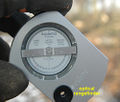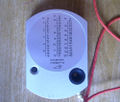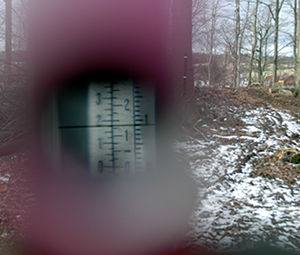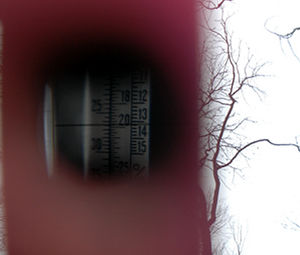Suunto
| sorry: |
This section is still under construction! This article was last modified on 06/28/2012. If you have comments please use the Discussion page or contribute to the article! |
Contents |
General description
The Suunto ([figure 1]) is a device that is used to measure slope and tree heights within fixed distances (15m, 20m) to the tree using the trigonometric principle. Therefore the angles between the actor and the tree are measured. The Suunto has an optical rangefinder to measure distances (15m, 20m) optically and a sighting viewer to look on the height scales. The scales implemented are the same as the scales of Clinomaster, but there is additionally implemented a scale for slope measurements in %.
Handling
- Select desired distance (15m, 20m) to the tree
- Sight the tree bottom with both eyes open (figure 2) and remember the value
- Sight the tree crown (figure 3) and remember the value
- Tree height is calculated as \[ {h_t} = {h_c} - {h_b} \].
To measure tree heights, aim the Suunto with both eyes open so that the hairline is superimposed. When the hairline is at the right place (e.g. bottom of the trunk) and the clinometer has stopped oscillating, remember the measurement value and measure the tree crown as you did before. The difference between the crown height and the bottom value is the tree height: Htotal = hcrown – hbottom
| Advantages | Disadvantages |
|---|---|
| slope correction implemented | measurement result needs to be remembered |
| optical distance measurement | fixed distances to the tree (could be difficult in closed forest stands) |
| independence of power sources (no batteries needed) | in dark forest stands optical measurement is difficult, no digital storage of measurement results available. |



